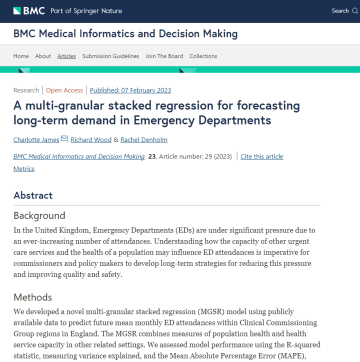Forecasting long-term demand in emergency departments
- 8 February 2023
Policies designed to improve both health-related behaviours and personal circumstances could reduce the number of people attending emergency departments (ED) and improve the quality and safety of care in the long-term. Researchers from Bristol’s BRC combined statistical models looking at population health and health service capacity to predict monthly ED attendances.
The number of people attending emergency departments in the UK is increasing. This puts pressure on departments and the service they are providing. Being able to forecast how many people are likely to attend an ED is important because of resource distribution and planning within a department. Understanding what is behind this increase and how health programmes could improve the situation would also be helpful for policy makers.
The study team used publicly available data to develop a statistical model for predicting monthly ED attendance. Their model, a Multi-Granular Stacked Regression (MGSR), combined data about population health (including socioeconomic deprivation), the number of calls answered by ambulance services and capacity in other health services such as GP surgeries or NHS 111.
The MGSR was then used to assess how changes in service capacity and population health might impact ED attendances in the future. Researchers found that changes to overall population health would have the largest instant impact and could potentially reduce the number of people attending EDs.
The team also found that increasing the capacity of the ambulance service would also increase the number of people attending EDs. This may be explained by the fact that the number of calls people make to the emergency services each month always exceeds the number of calls that are answered. If ambulance capacity is increased, meaning more calls are answered, more people will be taken to hospital.
According to the results, improving health-related behaviours and personal circumstances would have the biggest impact on reducing ED attendances. This suggests that policy makers should focus on interventions to reduce the number of people who smoke or abuse alcohol, they should tackle obesity and improve vaccination coverage as this could have the biggest long-term impact on ED demand.
Dr Charlotte James, lead author, said:
“Our MGSR model can be used by both strategic commissioners and policy makers. Commissioners can use our service capacity model to assess how additional spending, or spending cuts, in other services will impact monthly ED attendances. Using the model to determine how spending on one service impacts other services would allow for both cost and service capacity to be optimised across a region.
“Policy makers can look at our population health model to understand how health interventions might impact ED attendances. Working alongside service planners, the value of an intervention could be assessed through its impact on both population health and reduction in cost for the local health service.”
Dr Rachel Denholm, co-author, said:
“There is a large volume of work about forecasting short-term ED demand based on past attendance, calendar and meteorological variables.
“Other types of studies suggest that social deprivation and co-morbidities also predict ED attendance, while low GP attendance is associated with low ED attendance.
“This suggests models used for forecasting need to incorporate measures of overall population health and access to other health services.”
